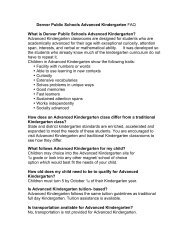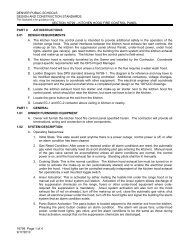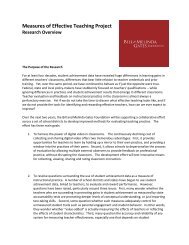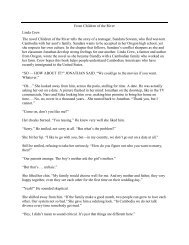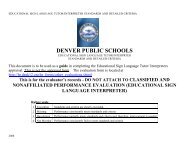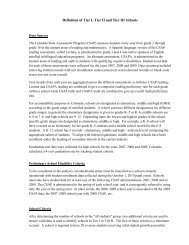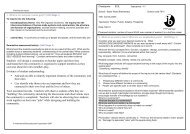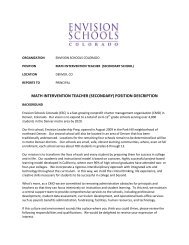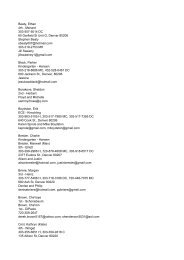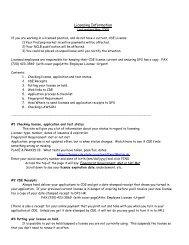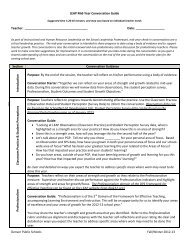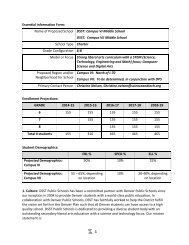Employee Brief: Your Self-Assessment
Employee Brief: Your Self-Assessment
Employee Brief: Your Self-Assessment
Create successful ePaper yourself
Turn your PDF publications into a flip-book with our unique Google optimized e-Paper software.
<strong>Employee</strong> Performance Management Process<br />
August 2012<br />
<strong>Employee</strong> <strong>Brief</strong>: <strong>Your</strong> <strong>Self</strong>-<strong>Assessment</strong><br />
This brief is provided to help document your self-assessment<br />
and think about your 2011-12 performance.<br />
1
The purpose of this document is to:<br />
PURPOSE<br />
Provide instructions for completing your self-assessment<br />
Help you understand the rating process<br />
Supply tips on how to best document your performance to show the impact of your<br />
contributions over the past year<br />
Note: The <strong>Self</strong>-<strong>Assessment</strong> must be completed by anyone with more than 6 months service by August 27 th . <strong>Employee</strong>s with<br />
at least 90 days of service are encouraged to document accomplishments and key learnings as a basis for goal-setting<br />
Key Dates<br />
<strong>Employee</strong>s submit self-assessments to managers: by Aug 27<br />
Managers complete draft evaluations: by Sept 9<br />
Department norming process*: Sept 11 – Sept 19<br />
Senior Leadership Team review: Sept 24<br />
Performance evaluation meetings: Sept 25 – Oct 12<br />
*What is a Norming Process?<br />
Resources<br />
Website: http://hr.dpsk12.org/performance_forms<br />
Contact your manager, HR Partner, or a member of the EPMP<br />
team at dpsepmp@dpsk12.org. You can reach EPMP Manager<br />
Pam Tanner directly at pamela_tanner@dpsk.12.org.<br />
The norming process facilitates consistency and fairness in overall performance ratings within and across departments.<br />
It includes the following steps:<br />
Senior Leadership Team meeting to discuss and norm ratings for their direct reports.<br />
Each Senior Leadership Team member cascades a norming process within their organization.<br />
The distribution of performance ratings across managers is reviewed by department leadership.<br />
A final review is conducted by the Senior Leadership Team.<br />
2
INSTRUCTIONS<br />
<strong>Employee</strong> <strong>Self</strong>-<strong>Assessment</strong><br />
HOW TO GET STARTED (EMPLOYEES)<br />
1. Review this brief for detailed instructions on how to document your self-assessment, guidance on how to think about<br />
performance, and examples of documentation.<br />
2. Copy your goals for 2011-12 into the ‗Individual Goals‘ section of the form.<br />
If you do not have documented goals, document your actual results in the ‗Results‘ boxes.<br />
You do not need to backfill ‗Goal Statements‘ or ‗Performance Indicators‘, but reference appropriate performance<br />
indicators in documenting results.<br />
3. If you identified any ‗Additional Performance Factors‘ or areas of focus for ‗Success Factors‘ or ‗People Management‘<br />
at the beginning of the year, copy those into the appropriate section of the form.<br />
4. Document your assessment of goal achievement and impact in the ‗<strong>Employee</strong> Comments‘ fields for each goal;<br />
success factor; people management section and additional performance factors (if applicable).<br />
5. Be sure to complete all applicable sections of the form. You can provide overall comments on your performance on<br />
the Year-End Performance Summary page; it is optional. The rest of the form, including your comments on the<br />
performance review and signatures, will be completed in your Performance Review session.<br />
6. Save a copy of your self-assessment on your computer or in a network folder.<br />
7. Complete your self-assessment by emailing it to your manager by August 27, 2012.<br />
3
INSTRUCTIONS<br />
Manager Evaluation<br />
HOW TO GET STARTED (MANAGERS)<br />
1. Review the performance evaluation form for instructions regarding how to document your evaluation.<br />
2. For each section of this performance evaluation form:<br />
a. Review the employee‘s self-assessment.<br />
b. Document your evaluation in the ‗Manager Comments‘ fields. Build upon the employee‘s self-assessment and/or<br />
note, specifically, any areas where your evaluation differs from the employee‘s assessment and why.<br />
c. Apply a performance rating in the ‗Manager Ratings‘ fields using the specific rating scale for each section.<br />
3. Be sure to complete all applicable sections of the form. The rest of the form, including the employee‘s comments on<br />
the performance review and signatures, will be completed in the Performance Review session.<br />
4. Complete a draft of all <strong>Employee</strong> Performance Reviews by September 10 for norming sessions to be conducted<br />
September 11-19. <strong>Your</strong> department head will provide more details regarding the time and location.<br />
5. Once norming sessions have been held and ratings finalized by the Senior Leadership Team, meet with your<br />
employee to hold a Performance Review and Goal Setting Session between September 25 and October 12.<br />
6. In the Performance Review and Goal Setting Session, discuss the employee‘s and your views on the employee‘s<br />
performance. Provide the employee an opportunity to write comments in the Year-End Performance Summary.<br />
7. Print and sign the finalized performance review. Be sure to get the employee‘s signature as well.<br />
8. By October 31, please print and interoffice mail the completed performance review to: Pam Tanner, Human<br />
Resources, Room 501, 900 Grant Street.<br />
4
THE PERFORMANCE RATING PROCESS<br />
Based on feedback that it was difficult to apply the overall rating scale to individual goals, Success Factors and<br />
other performance factors, there are now three separate rating scales, as described below. The overall rating scale<br />
focuses on results and impact.<br />
When rating these aspects of<br />
Goal Achievement or<br />
Success Factors* or<br />
performance:<br />
Other Performance Factors<br />
People Management<br />
EX – Exceeded RM - Role Model<br />
These scales will be applied: ME – Met FP - Full Proficiency<br />
PM – Partially Met DE- Developing<br />
DN – Did Not Meet NI - Needs Improvement<br />
*Click here to review ―Success Factors‖ (or see Appendix)<br />
When Overall Performance is rated, this scale will apply:<br />
Level Rating Definition<br />
5<br />
Results and Impact<br />
Exceed Expectations<br />
Impact exceeds expectations for the role. Makes exceptional contributions through<br />
superior performance on key goals; role model in demonstrating DPS Success Factors.<br />
Demonstrates high degree of skill and competency.<br />
4<br />
Results and Impact Fully<br />
Meet Expectations<br />
Makes significant contributions and impact by meeting key goals and performance<br />
indicators and demonstrating full proficiency in DPS Success Factors and critical job skills.<br />
3<br />
Results and Impact<br />
Generally Meet<br />
Expectations; Opportunity<br />
to Expand Impact<br />
Solid contributor who generally meets goals but could expand impact in their role. Further<br />
consistency, demonstrated impact in key areas, or development in DPS Success Factors<br />
is required to realize full potential within the role. Demonstrates the willingness and ability<br />
to grow.<br />
2<br />
1<br />
Results and Impact Need<br />
Improvement<br />
Results and Impact Are<br />
Unsatisfactory<br />
Impact is below that expected for the role. Results do not meet expectations for<br />
experience and job level. May have missed an important goal or goals, or require different<br />
development in a key skill area or Success Factor. Short-term performance development<br />
plan is required.<br />
Did not meet key goals and/or does not demonstrate proficiency in critical job skills or<br />
DPS Success Factors. Immediate and significant performance improvement is required.<br />
Performance Improvement Plan with specific timeline (generally less than 6 months) is<br />
required.<br />
5
HOW TO THINK ABOUT YOUR PERFORMANCE<br />
Our shared goals as an organization—that we close our achievement gaps and put every child on a path to graduate from<br />
high school prepared for college and career—are stretch goals. We will only achieve our district goals if every employee<br />
challenges him/herself to set and achieve ambitious goals which move the bar in a significant way. The <strong>Employee</strong><br />
Performance Management Process (EPMP) is intended to be a transformative process that propels the district forward in<br />
meeting its goals.<br />
As you evaluate your own performance, remember:<br />
When we evaluate school performance, ―meeting<br />
expectations‖ requires schools to have made<br />
significant progress to close the achievement gap.<br />
When we evaluate individual performance, ―meeting<br />
expectations‖ requires creating meaningful impact<br />
within the scope of the individual‘s role.<br />
Click here for the following FAQs (or see Appendix):<br />
Q: Why did the rating process change in 2010-11?<br />
Q: Does a “3” rating mean I‟m considered to be a poor performer?<br />
Q: If I don‟t work directly with students, how can I have an impact on closing<br />
the achievement gap and support District goals?<br />
Q: Is there a distribution of performance ratings each group is expected to<br />
meet?<br />
6
HOW TO DOCUMENT YOUR SELF-ASSESSMENT<br />
Writing a self-assessment provides an important opportunity for reflection; a time to objectively consider your performance. It<br />
will also help your manager more clearly see the results you have accomplished and the impact you have had in the past<br />
year. The more specific and objective you are in your self-assessment, the more you will learn from the process, and the<br />
more effective the self-assessment will be in informing your manager‘s evaluation of your performance.<br />
In order to fully demonstrate your performance you will want to clearly document:<br />
The specific results you accomplished, highlighting your most important accomplishments.<br />
<strong>Your</strong> most significant challenges, acknowledging where was progress more limited.<br />
The impact you had; how did your efforts better position your team, department and DPS to achieve its goals?<br />
Where you challenged and improved upon the status quo and created meaningful change.<br />
How you demonstrated the DPS Success Factors in achieving your goals.<br />
Any new roles you took on and new skills you applied.<br />
Lessons you learned and how you can apply these lessons going forward.<br />
<strong>Your</strong> documentation should be linked to the goals you set at the beginning of the year,<br />
specific and factual, and thorough but concise.<br />
Highlight the most important outcomes and indicators of our performance. Note variances – both positive and<br />
negative – from the goals and performance indicators set at the beginning of the year.<br />
The more weight a goal has, the more documentation you will want to provide on goal achievement.<br />
7
DOCUMENTING GOAL ACHIEVEMENT<br />
In documenting goal achievement, focus not just on activities that you completed, but more importantly, the quality of the<br />
results and the impact you had. An activity explains what you did – the individual steps or actions you took to deliver on a<br />
goal. Impact explains why it mattered.<br />
For each goal:<br />
How did you:<br />
Impact student achievement and growth?<br />
Contribute to improved school performance and educator<br />
effectiveness?<br />
Improve service to or engagement with students and parents?<br />
Improve operating efficiency and financial management?<br />
Improve the District‘s physical assets?<br />
Enable your customers and peers to be more effective?<br />
1. Document measurable outcomes where possible, referring back to the performance indicators defined at the<br />
beginning of the year.<br />
o Where quantitative metrics aren‘t possible, describe performance results and impact in terms of objective<br />
observations (e.g., observed behaviors, observed changes in processes and outcomes, observations on<br />
quality of deliverables, feedback received.)<br />
2. Consider the process by which goals were achieved. How did you demonstrate the Success Factors in achieving<br />
your goals?<br />
3. Note areas in which you could have been more effective and opportunities for development you identified, to ensure<br />
continuous improvement and growth.<br />
8
DOCUMENTING GOAL ACHIEVEMENT (CONT.)<br />
Results documentation should focus on impact versus activities.<br />
Examples<br />
(Objective performance metrics should be provided to support impact statements wherever possible)<br />
Activities Impact<br />
Developed new mentoring program for 1 st -year teachers<br />
identified as ―at risk‖<br />
Implemented data-based intervention process for at-risk<br />
freshmen<br />
Implemented new project management software and trained<br />
users<br />
Increased the effectiveness of program participants as<br />
measured by teacher observers and year-end performance<br />
ratings.<br />
Percentage of freshmen on track to graduate based on<br />
credits earned increased almost 5%; educators rated<br />
process as highly effective and a model for other<br />
development efforts.<br />
Example documentation for goal achievement is provided in the following pages.<br />
Click here for these FAQs (or see Appendix):<br />
Q: What if I didn‘t achieve a goal?<br />
Click here Q: (or What see if Appendix) I don‘t have for 2011-12 these FAQs. goals?<br />
Q: How do I report unplanned but significant accomplishments?<br />
Click here (or see Appendix) for these FAQs.<br />
New project management software supports central tracking<br />
of projects across teams, enabling early identification of atrisk<br />
projects and re-allocation of resources to highest areas<br />
of need.<br />
9
DOCUMENTING GOAL ACHIEVEMENT – EXAMPLE<br />
Cut and paste goals and performance indicators that you had set at the beginning of the year into the 2011-12 <strong>Self</strong>-<br />
<strong>Assessment</strong> and Performance Evaluation Form.<br />
Goal Statement: Develop and implement new orientation and on-boarding process for new transportation employees to<br />
facilitate retention and minimize time to full productivity.<br />
Performance Indicators:<br />
o New onboarding process implemented by October 1, 2011<br />
o First 30 day regretted turnover under 10% by May 1, 2012<br />
o 85% of new hires surveyed after 30 days indicate satisfied or higher with job placement<br />
o 95% of new employees rated as fully proficient by supervisors at 30 days after hire<br />
o Process encompasses district, department and team protocols and performance standards<br />
Results: I completed this goal and met all of the performance indicators, with the exception of the 30-day proficiency rating.<br />
Only 70% of the new employees were rated as fully proficient at 30 days, but supervisory input was that 30 days is too short<br />
of a measurement period for some jobs. I am in-process of working with the supervisors to determine the appropriate<br />
measurement timeframe for each job. I worked with people across the department as well as with HR to make sure that<br />
the program had the right content and would prepare new employees to be successful. I also did a survey of employees that<br />
started in the department without the benefit of orientation to find out what information would have helped them in the first<br />
week, month and quarter. This helped to make sure the program not only had the right content, but that it was delivered to<br />
new employees at the right time. While I met the October 1 implementation deadline, better coordination with the<br />
administrative assistants would have prevented some after-the-fact re-work; I need to do a better job of identifying all key<br />
stakeholders up-front.<br />
10
Important Note: If you did not document goals and performance indicators at the beginning of the year, or<br />
if you had an unplanned goal, do not backfill these fields. Document key accomplishments in the „Results‟<br />
boxes. Be sure to include relevant performance indicators in documenting results.<br />
DOCUMENTING GOAL ACHIEVEMENT – EXAMPLE<br />
Results:<br />
While not one of my initial goals, a key accomplishment this year was assuming a project management role for<br />
department communications. I heard frequent complaints about the lack of information about what was going on in<br />
the department and misinformation about district initiatives. I believed this was a critical need and outlined potential<br />
objectives and benefits. My manager agreed to my allocating time to develop and test a communications plan for<br />
the department. I read literature on best practices in employee communications on my own time, conducted two<br />
employee focus groups to understand information needs and frustrations, and met with department leadership to<br />
understand their perceptions of communication needs and what they were willing to take on. I developed a draft<br />
communication plan that outlined key communications points and vehicles, taking care to ensure required time<br />
commitments on the part of department leadership were reasonable and leveraging the District‘s communications<br />
team wherever possible. I received buy-off from the leadership team on the plan and approval from my manager to<br />
continue project managing during a pilot. After a 6-month pilot, leadership has agreed to continue the plan. A<br />
follow-up employee focus group indicated employees felt more connected to the department and more informed of<br />
district initiatives. I have learned a lot about employee communications and building a business case to support a<br />
goal; I need to work on managing my time in other areas to allow adequate time for this new responsibility.<br />
Click here for additional examples of documentation related to goal achievement (or see Appendix).<br />
11
DOCUMENTING SUCCESS FACTORS<br />
DPS Success Factors define our core values, what we stand for and stand on. They are actions<br />
that are critical to the success of DPS and expected of every employee. Documenting results is<br />
about what you have accomplished. Success Factors speak to how you accomplished the results.<br />
Click here to review ―Success Factors Definitions‖ (or see Appendix).<br />
Provide examples and document specific behaviors that demonstrate your performance on each<br />
Success Factor, and describe the impact of your performance in this area on goal achievement.<br />
Example<br />
Deliver Excellent Service: Not only do I respond immediately to concerns, but I also try to talk often with my<br />
stakeholders so that I can anticipate and prevent problems from happening and better anticipate needs that they have.<br />
This has contributed directly to enhanced results on the principal‘s survey. One specific example was when I raised the<br />
issue that customers were frustrated with slow response times. I conducted meetings with all teams involved in the<br />
process to understand what was impacting response time, and used the feedback to evaluate the current process and<br />
work with team leaders in developing improvement plans. As a result, response time has started to trend downward<br />
(from 72 to 68 hours) and key stakeholders report less frustration with the process.<br />
Example<br />
Collaborate: I demonstrated my ability to collaborate when I created the training program for new volunteers. Instead<br />
of designing the program based on only my own experience, I took the initiative to solicit input and guidance from<br />
experienced volunteers, principals and other leaders in the district. During the process I also mentored a coworker who<br />
needs further experience in program development and implementation. Based on prior feedback, I have paid specific<br />
attention to ensuring I‘m proactively communicating with team members, which has increased their willingness to<br />
support my projects. I need to continue to get better at soliciting their input before decisions are made; they had good<br />
ideas with respect to program logistics that caused last-minute rework.<br />
Q: How do we balance Goals and Success Factors in<br />
evaluating overall performance?<br />
For answer, Click here (or see Appendix)<br />
12
DOCUMENTING ADDITIONAL PERFORMANCE FACTORS AND PEOPLE MANAGEMENT<br />
The EPMP form provides the opportunity to document any ‗Additional Performance Factors‘ that should be considered in<br />
assessing your overall performance (e.g., knowledge/skills/abilities, certifications, attendance, policy compliance, standards<br />
of conduct, etc.). There is also a ‗People Management‘ Factor for those who supervise others. Document results in these<br />
areas using the principles discussed previously in this document. Specifically address any goals or areas of focus identified at<br />
the beginning of the year.<br />
SUMMARIZING OVERALL PERFORMANCE (OPTIONAL)<br />
While optional, you may summarize your self-assessment in the ―Year-End Performance Summary‖ section of the form. You<br />
may want to highlight:<br />
Major Accomplishments and How You<br />
Created Impact<br />
Missed Goals – How You Will Address,<br />
What You Learned<br />
How You Have Grown and Goals for Future<br />
Development<br />
13
EXAMPLES OF OVERALL PERFORMANCE SUMMARIES<br />
Example<br />
This year I have worked to create meaningful change in terms of our service levels to schools. Key accomplishments<br />
included quarterly needs assessments, streamlining the work order system, and implementing customer service training and<br />
performance standards for department employees. I took a systems approach to my goals, approaching them as<br />
components of an integrated solution, and benchmarked other service-oriented departments to understand best practices. I<br />
took full ownership of results, ensuring the projects were not just completed, but completed with deep attention to quality and<br />
impact. I developed stronger skills in two specific Success Factors: Collaborate and Make Change Happen. My goal is to<br />
develop stronger analytical and presentation skills so that I can present solid business cases and better demonstrate the<br />
impact of my efforts.<br />
Example<br />
I fully met 3 out of 5 goals, and played a key role in increasing communication and collaboration within our team. However, I<br />
missed milestones and other performance indicators on two key system implementations. In retrospect, I realize that I should<br />
have received buy-off from key stakeholders in defining priorities, resource requirements and milestones. I was unable to get<br />
key people to devote the required time to defining system requirements and realistic milestones. I tried to fill the gaps but<br />
ended up with considerable rework when system owners finally got involved. My drive to accomplish results and ―make it<br />
easy‖ for stakeholders got in the way of the stakeholder participation I know is so important.<br />
14
DPS Success Factors<br />
Additional Examples:<br />
FAQs:<br />
APPENDIX<br />
o Goal Statement with Performance Indicators<br />
o Documenting Goal Achievement<br />
o The Rating Process<br />
o Documenting Performance<br />
Click here to return to top of document.<br />
15
DPS SUCCESS FACTORS<br />
Follow this link: http://hr.dpsk12.org/performance_forms or see 2011-12 <strong>Self</strong>-<strong>Assessment</strong> and Performance Evaluation<br />
Form for representative behaviors for each Success Factor.<br />
DPS Success Factors Definition<br />
Put Students First Puts students first in setting priorities and delivering results.<br />
Achieve Results Sets aggressive goals, focuses on key priorities, and assumes responsibility for results.<br />
Collaborate Works proactively with others to achieve common goals.<br />
Deliver Excellent Service Takes responsibility for understanding and effectively addressing needs of students and<br />
other stakeholders.<br />
Make Change Happen Seizes opportunities for improvement and promotes positive change.<br />
Click here to return to ―Documenting Success Factors‖<br />
16
ADDITIONAL EXAMPLE: GOAL STATEMENT WITH PERFORMANCE INDICATORS<br />
Click here to return to ―Documenting Goal Achievement‖<br />
EXAMPLE<br />
Goal Statement: Increase the number of freshmen and sophomores who finish the 2011-12 school year on track to<br />
graduate<br />
Performance Indicators:<br />
o Develop intervention planning system based on key metrics<br />
o 90% of freshmen and 95% of sophomores have Personal Education Plan in place by end of October<br />
o 80% of freshmen and 85% of sophomores on-track to graduate based on credits earned<br />
o Educator survey assessing perceived effectiveness of support provided<br />
Results: While results fell short of targets, substantial progress was made; 74% of freshmen and 81% of sophomores were<br />
on track to graduate as of the end of the school year. The process of getting stakeholder input to and review of proposed<br />
processes and tools took longer than expected, but it was invaluable in ensuring their ultimate buy-in as evidenced by an<br />
average 4.4 rating in the follow-up stakeholder survey. I also took the time to conduct student focus groups; in addition to<br />
providing valuable input, participants served as champions of the process. I recognized that it would be difficult to hold<br />
formal teacher training sessions to launch the process so I worked with school leadership and counselors to develop an<br />
implementation plan for each school. While very time consuming (it prevented me from reaching another goal), I believe the<br />
success of that strategy was evidenced by the fact that 90% of freshmen and 96% of sophomores had a Personal<br />
Education Plan in place by January 1. The intervention planning system I developed can ultimately be embedded into the<br />
Spotlight Report, but I have not yet been successful in securing buy-off from the necessary stakeholders. In retrospect, I<br />
realize I needed to present a more well-developed business case to secure their support.<br />
17
ADDITIONAL EXAMPLE: DOCUMENTING GOAL ACHIEVEMENT<br />
Results:<br />
A key goal this year was to improve training and support to schools on successful teacher hiring, including<br />
screening and identification of high-potential candidates. I developed an advisory group of principals to identify<br />
current challenges and evaluate potential solutions; benchmarked best practices of both academic and nonacademic<br />
organizations; and developed a screening tool based on the profile of current teachers identified as<br />
high-potential. Training in the new assessment tool was launched in April; there was significant resistance to<br />
adding more structure to the interview process but I was able to anticipate the resistance based on Advisory<br />
Team input and had worked with the HR partners to develop a coaching process which helped make them more<br />
comfortable with the process. 83% of the principals participated in the training program, with 77% rating it<br />
effective or above, and 78% of the participants in the pulse survey conducted following the spring screening<br />
believed the new process had made them more effective interviewers. The impact of these efforts will not be<br />
known until the next round of hires, but I have developed a set of metrics to measure both short- and long-term<br />
success.<br />
Click here to return to ―Documenting Goal Achievement‖<br />
18
Q: Why did the rating process change in 2010-11?<br />
A: We changed the rating process to:<br />
1. Enhance focus on performance results and<br />
impact. To provide the right incentives to set<br />
stretch goals and exceed them, the overall<br />
rating will emphasize an individual‘s overall<br />
impact (within the scope of their role), rather<br />
than the number of goals they met.<br />
2. Better differentiate performance levels. The<br />
five-point scale for rating overall performance<br />
was developed in response to feedback that the<br />
prior scale did not enable managers to<br />
distinguish between generally solid performers<br />
who have the opportunity to expand their impact<br />
and employees with more significant<br />
development needs.<br />
3. Make the ratings easier to apply. It was hard to<br />
Click apply Here the to definitions Return of to the ―How overall to performance<br />
ratings to individual goals and Success Factors.<br />
FREQUENTLY ASKED QUESTIONS - THE RATING PROCESS<br />
Q: Is there a distribution of performance ratings each group is expected to meet?<br />
Click here to return to ―How to Think About <strong>Your</strong> Performance‖<br />
Q: Does a “3” rating (Results Meet Most But Not All Expectations; Opportunity to<br />
Expand Impact) mean I‟m considered to be a poor performer?<br />
A: No. To achieve our goals as a district, we need to set very challenging team and<br />
individual goals, and it‘s likely some won‘t be achieved. If we made good progress on an<br />
issue, if we learned something new, that‘s OK. We also need to continuously expand our<br />
capacity to perform – to expand our knowledge, skills and abilities. Identifying an<br />
employee as someone who has an opportunity to expand impact or needing<br />
development doesn‘t mean they‘ve failed; only that further work is required to expand their<br />
impact and their ability to drive change in their role.<br />
Q: If I don‟t work directly with students, how<br />
can I have an impact on closing the<br />
achievement gap and support District<br />
Goals?<br />
A: Even if you don‘t impact students directly,<br />
you impact the effectiveness of the District by<br />
ensuring service is outstanding, processes are<br />
efficient, and resources are used as effectively<br />
as possible to help other be more effective in<br />
their role.<br />
A: No, but leadership expects to see a reasonable relationship between the performance of the district and the performance<br />
distribution of employees. If we‘ve set the right goals with sufficient stretch, and the majority of employees meet or exceed their<br />
goals, we should be meeting or exceeding our goals as a district. We‘re not; we‘re an organization that‘s in need of significant<br />
growth. We need individuals within our system to set stretch goals and exceed them in order significantly improve our results as<br />
a district and exceed them. Also something about high expectations for both adults and students … At the same time, we also<br />
need to ensure consistency and fairness in goals and evaluations across groups. If one group‘s performance distribution is<br />
significantly higher (or lower) than the norm, the leader will need to build a case to support that difference.<br />
19
FREQUENTLY ASKED QUESTIONS – DOCUMENTING PERFORMANCE<br />
Q: What if I didn‟t achieve a goal?<br />
A: Explain why you didn‘t achieve the goal. Were<br />
there barriers that simply couldn‘t be overcome?<br />
Did priorities shift? If so, describe results relative to<br />
the new priorities.<br />
Q: What if I made an unplanned but significant accomplishment?<br />
A: Document the accomplishments in the ‗Results‘ field or ‗Overall<br />
Performance Summary,‘ indicating that this was an unplanned<br />
accomplishment.<br />
Q: How do we balance „Goals‟ and „Success Factors‟ in evaluating overall performance?<br />
A: We believe the Success Factors will drive our success as an organization and they should be given appropriate<br />
consideration in determining overall performance ratings. While there‘s no set formula for determining overall<br />
ratings, as guidance, the Success Factors should generally carry approximately 20 – 30% weight. The appropriate<br />
weight may be higher than that if warranted by individual circumstances (e.g., critical development needed.)<br />
Click Here to Return to ―Documenting Goal Achievement‖<br />
Q: What if I don‟t have 2011/2012 goals?<br />
A: Do not create ‗retroactive goals‘. Document<br />
your actual results in the ‗Results‘ field, referencing<br />
relevant performance indicators. Leave the ‗Goal<br />
Statement,‘ ‗Performance Indicators‘ and ‗District<br />
Goal Supported‘ fields blank.<br />
20




